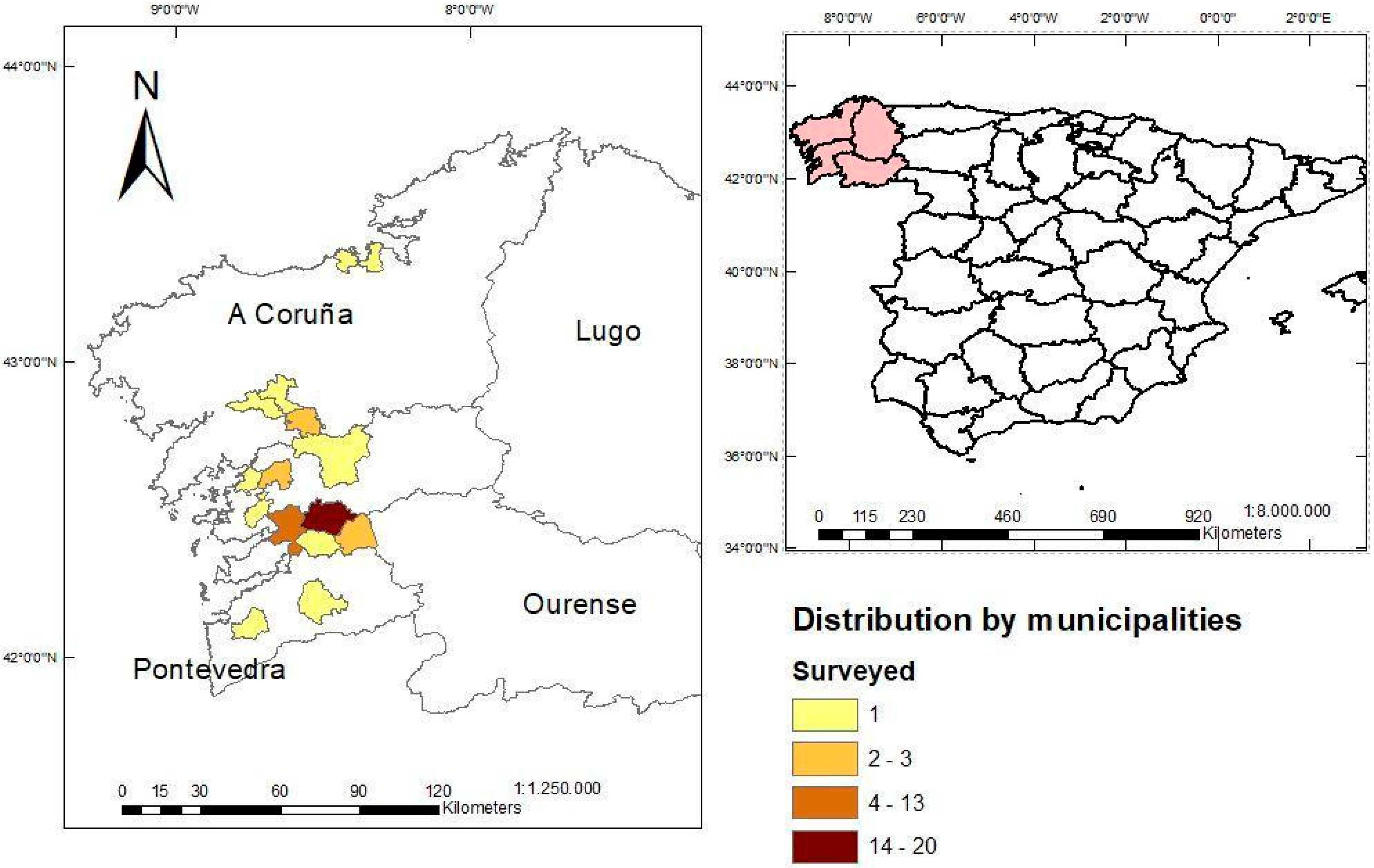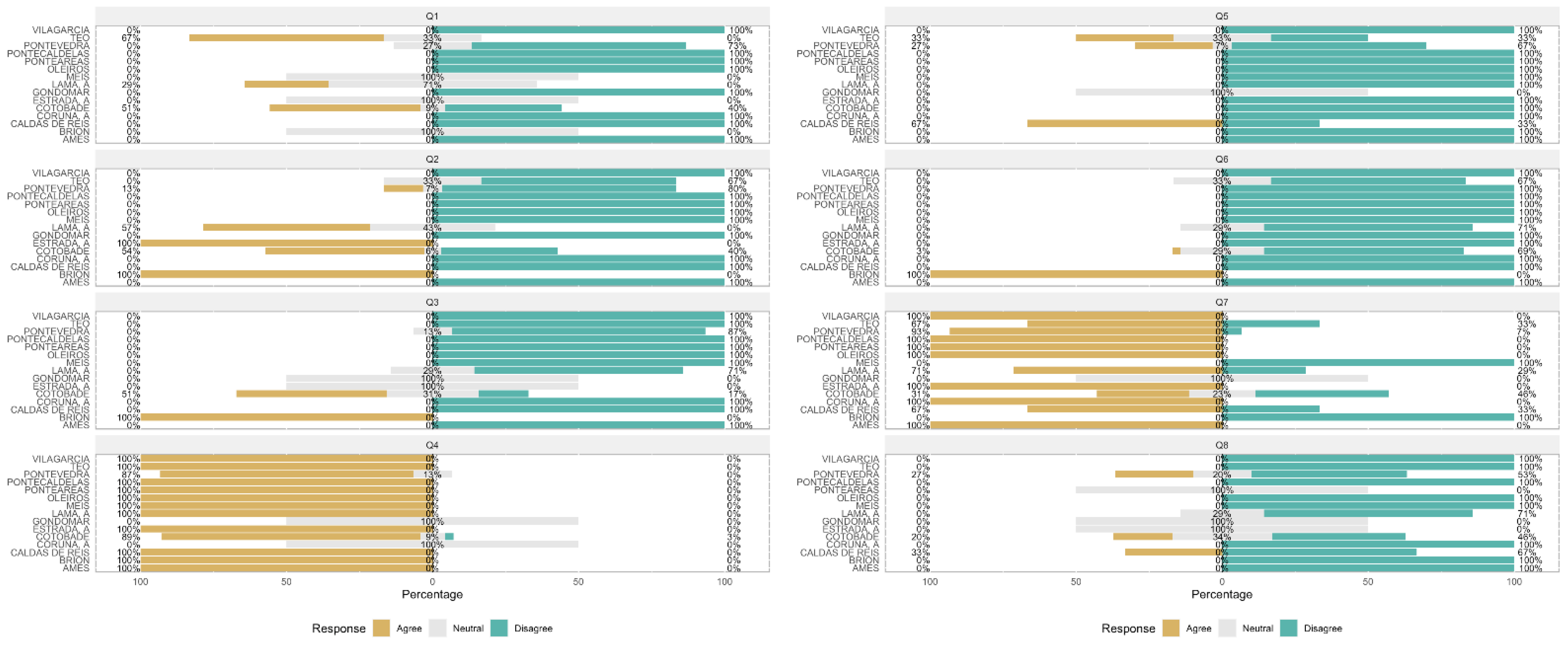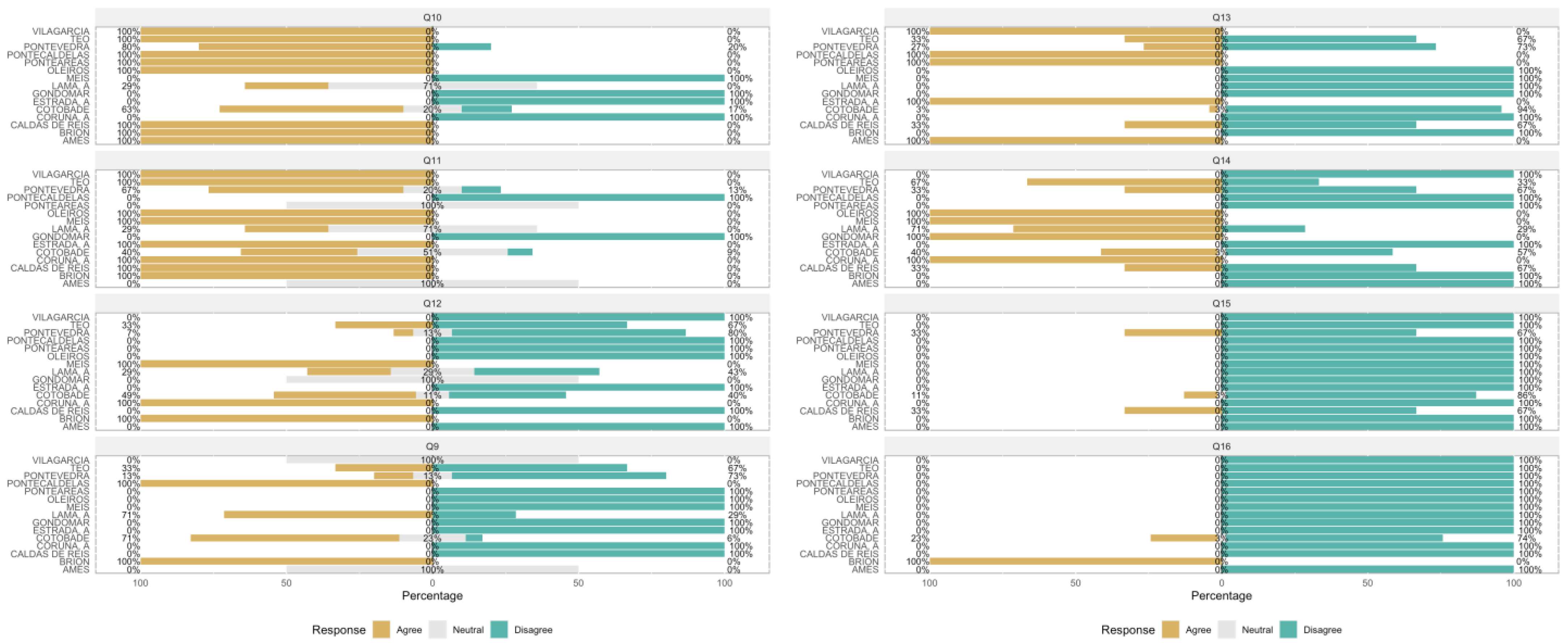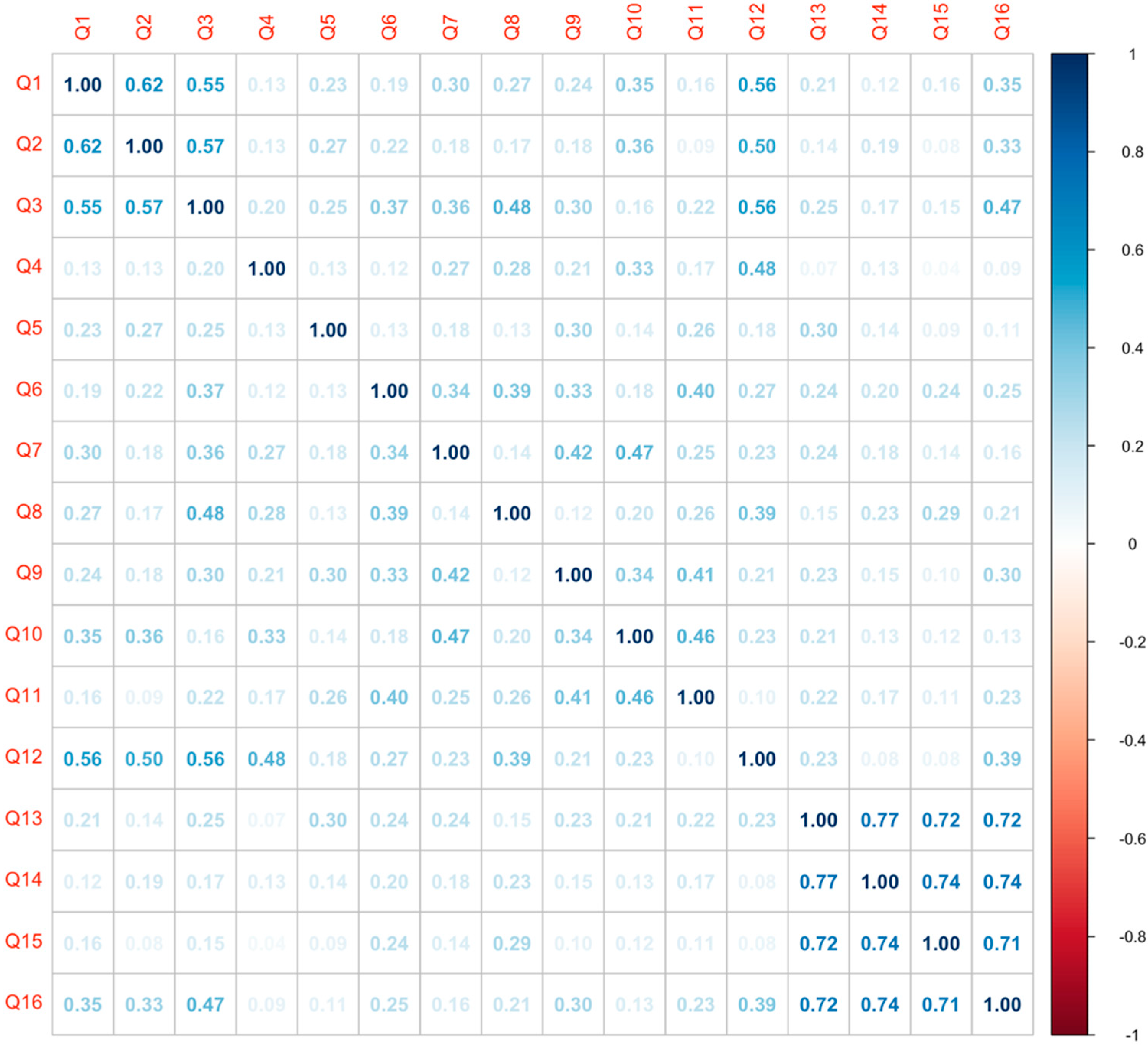Factors Influencing Human Attitudes towards Wolves in Northwest Spain
Abstract
1. Introduction
2. Materials and Methods
2.1. Area of Study and Questionnaires
2.2. Statistical Analysis
3. Results
3.1. Comparison of Patterns of Attitude, Opinion and Consideration between Stakeholder Groups
3.2. Ordinal Logistic Regression Model
4. Discussion
5. Conclusions
Author Contributions
Funding
Institutional Review Board Statement
Informed Consent Statement
Data Availability Statement
Conflicts of Interest
Appendix A
- Questionnaire
- Q1.
- Do you consider the wolf population in your area is greater than the territory capacity?
- I agree
- I disagree
- Neither agree nor disagree
- Q2.
- Do you consider the damages caused by wolves in your area are numerous?
- I agree
- I disagree
- Neither agree nor disagree
- Q3.
- Do you consider the wolf as a harmful species?
- I agree
- I disagree
- Neither agree nor disagree
- Q4.
- Do you consider important the presence and management of the Galician Horse as a way to reduce damages produced by wolves?
- I agree
- I disagree
- Neither agree nor disagree
- Q5.
- Do you consider the current tools used by the Galician Administration are enough and effective to palliate the damages produced by wolves?
- I agree
- I disagree
- Neither agree nor disagree
- Q6.
- The losses and damages caused by wolves are part of cattle raising and should not be compensated:
- I agree
- I disagree
- Neither agree nor disagree
- Q7.
- Should compensation programmes continue even when wolves no longer pose a threat or danger:
- I agree
- I disagree
- Neither agree nor disagree
- Q8.
- My tolerance towards wolves would decrease if there were not compensation measures in place:
- I agree
- I disagree
- Neither agree nor disagree
- Q9.
- I worry that as wolf populations begin to settle, it will be too expensive to keep funding compensation programmes:
- I agree
- I disagree
- Neither agree nor disagree
- Q10.
- If a person believes they have lost an animal as a results of a wolf attach, they should… (chose only one answer):
- Be compensated regardless of how they manage their livestock
- Be compensated only if they manage their livestock following appropriate practices (ex: correct removal of dead animals)
- Not be compensated
- Q11.
- If a person believes they have lost an animal as a results of a wolf attach, they should… (chose only one answer):
- Be compensated only if they show proof of the attack
- Be compensated only if administration employees find proof of the attack
- Not be compensated
- Q12.
- Do you consider it necessary to reimburse farmers for the preventive measure established by them to avoid wolves’ attacks on their livestock? (ex: surveillance dogs, electric fences, rubber bullets, etc.):
- I agree
- I disagree
- Neither agree nor disagree
- Q13.
- Do you consider it necessary to create a fund to compensate farmers that suffer losses as a result of wolves’ attacks?
- I agree
- I disagree
- Neither agree nor disagree
- Q14.
- What is your opinion in using non-lethal tools such as surveillance dogs, electric fences and rubber bullets to prevent wolves’ attacks?
- I agree
- I disagree
- Neither agree nor disagree
- Q15.
- If a wolf kills a livestock animal, authorities should…:
- Not take any immediate action but should first monitor the situation
- Try to get the wolf to establish in a wild area
- Try to scare the wolf or to keep it away from the farm
- Kill the wolf
- Q16.
- Do you consider a wolf hunting season should be established?
- I agree
- I disagree
- Neither agree nor disagree
- Only
- for farmers:
- Order from highest to lower, the cause of death of your livestock:
- ○
- Direct predation
- ○
- Indirect predation (as a results of wounds)
- ○
- Other causes
- Do you own deterrent tools or methods? (chose all the answers that are applicable to you):
- ○
- Mastiff dogs
- ○
- Fences
- ○
- Electric Shepherd
- ○
- Others
- What are the wolves’ attacks you have suffered like? (chose all the answers that are applicable to you):
- Number of attacks per year:
- ○
- 1 attack
- ○
- 2–3 attacks
- ○
- More than three attacks
- Time of the year:
- ○
- Autumn
- ○
- Winter
- ○
- Spring
- ○
- Summer
- Place:
- ○
- Pastures
- ○
- Private property
- ○
- Mountains
References
- Bassi, E.; Willis, S.G.; Passilongo, D.; Mattioli, L.; Apollonio, M. Predicting the spatial distribution of wolf (Canis lupus) breeding areas in a mountainous region of Central Italy. PLoS ONE 2015, 10, e0124698. [Google Scholar] [CrossRef] [PubMed]
- Hosseini-Zavarei, F.; Farhadinia, M.S.; Beheshti-Zavareh, M.; Abdoli, A. Predation by grey wolf on wild ungulates and livestock in central Iran. J. Zool. 2013, 290, 127–134. [Google Scholar] [CrossRef]
- Musiani, M.; Paquet, P.C. The practices of wolf persecution, protection, and restoration in Canada and the United States. Bioscience 2004, 54, 50–60. [Google Scholar] [CrossRef]
- Janeiro-Otero, A.; Newsome, T.M.; Van Eeden, L.M.; Ripple, W.J.; Dormann, C.F. Grey wolf (Canis lupus) predation on livestock in relation to prey availability. Biol. Conserv. 2020, 243, 108433. [Google Scholar] [CrossRef]
- Mech, L.D. The challenge and opportunity of recovering wolf populations. Conserv. Biol. 1995, 9, 270–278. [Google Scholar] [CrossRef]
- Treves, A.; Karanth, K.U. Human-carnivore conflict and perspectives on carnivore management worldwide. Conserv. Biol. 2003, 17, 1491–1499. [Google Scholar] [CrossRef]
- Hindrikson, M.; Remm, J.; Pilot, M.; Godinho, R.; Stronen, A.; Baltrunaite, L.; Czarnomska, S.; Leonard, J.; Randi, E.; Nowak, C.; et al. Wolf population genetics in Europe: A systematic review, meta-analysis and suggestions for conservation and management. Biol. Rev. 2017, 92, 1601–1629. [Google Scholar] [CrossRef]
- Chapron, G.; Kaczensky, P.; Linnell, J.D.C.; von Arx, M.; Huber, D.; Andrén, H.; López-Bao, J.V.; Adamec, M.; Álvares, F.; Anders, O.; et al. Recovery of large carnivores in Europe’s modern human-dominated landscapes. Science 2014, 346, 1517–1519. [Google Scholar] [CrossRef]
- Maiorano, L.; Amori, G.; Montemaggiori, A.; Rondinini, C.; Santini, L.; Saura, S.; Boitani, L. On how much biodiversity is covered in Europe by national protected areas and by the Natura 2000 network: Insights from terrestrial vertebrates: Biodiversity Conservation in Europe. Conserv. Biol. 2015, 29, 986–995. [Google Scholar] [CrossRef]
- Trouwborst, A.; Fleurke, F.M. Killing Wolves Legally: Exploring the scope for lethal wolf management under European nature conservation law. J. Int. Wildl. Law Policy 2019, 22, 231–273. [Google Scholar] [CrossRef]
- Naughton-Treves, L.; Grossberg, R.; Treves, A. Paying for Tolerance: Rural citizens’ attitudes toward wolf depredation and compensation. Conserv. Biol. 2003, 17, 1500–1511. [Google Scholar] [CrossRef]
- Agarwala, M.; Kumar, S.; Treves, A.; Naughton-Treves, L. Paying for wolves in Solapur, India and Wisconsin, USA: Comparing compensation rules and practice to understand the goals and politics of wolf conservation. Biol. Conserv. 2010, 143, 2945–2955. [Google Scholar] [CrossRef]
- Fernández-Gil, A.; Naves, J.; Ordiz, A.; Quevedo, M.; Revilla, E.; Delibes, M. Conflict misleads large carnivore management and conservation: Brown bears and wolves in Spain. PLoS ONE 2016, 11, e0151541. [Google Scholar] [CrossRef]
- Arija, C. Biología y conservación del lobo ibérico: Crónica de un conflicto. REDVET XI. In Revista Electrónica de Veterinaria; Veterinaria Organización: Málaga, Spain, 2010; Volume 11, pp. 1–18. [Google Scholar]
- Valverde, J. El lobo español. Montes 1971, 159, 229–241. [Google Scholar]
- Ley 2/1973, de 17 de Marzo, de Creación de Trece Reservas Nacionales de Caza; Ministerio de Agricultura: Madrid, Spain, 1973.
- Blanco, J.C.; Reig, S.; de la Cuesta, L. Distribution, status and conservation problems of the wolf Canis lupus in Spain. Biol. Conserv. 1992, 60, 73–80. [Google Scholar] [CrossRef]
- Council of the European Union. Council Directive 92/43/EEC of 21 May 1992 on the conservation of natural habitats and of wild fauna and flora. Off. J. Eur. Union 1992, 206, 7–49. [Google Scholar]
- López-Bao, J.V.; Blanco, J.; Rodriguez, A.; Godinho, R.; Sazatornil, V.; Álvares, F.; García, E.; Llaneza, L.; Rico, M.; Cortés, Y.; et al. Toothless wildlife protection laws. Biodivers. Conserv. 2015, 24, 2105–2108. [Google Scholar] [CrossRef]
- Harper, E.; Paul, W.; Mech, L.; Weisberg, S. Effectiveness of lethal, directed wolf-depredation control in minnesota. J. Wildl. Manag. 2008, 72, 778–784. [Google Scholar] [CrossRef]
- Treves, A. Hunting for large carnivore conservation. J. Appl. Ecol. 2009, 46, 1350–1356. [Google Scholar] [CrossRef]
- Núñez-Quirós, P.; Llaneza, L. Análisis de la distribución histórica del lobo (Canis Lupus) en Galicia: 1850, 1960 Y 2003. Ecologia 2007, 21, 195–206. [Google Scholar]
- Llaneza, L.; López-Bao, J.V.; Sazatornil, V. Insights into wolf presence in human-dominated landscapes: The relative role of food availability, humans and landscape attributes. Divers. Distrib. 2012, 18, 459–469. [Google Scholar] [CrossRef]
- Censo Nacional 2012-2014 del lobo Ibérico (Canis lupus) en España [WWW Document], 2014. Available online: https://www.miteco.gob.es/es/biodiversidad/temas/inventarios-nacionales/inventario-especies-terrestres/ieet_mamiferos_censo_lobo.aspx (accessed on 9 November 2020).
- Linnell, J.; Boitani, L. Building biological realism into wolf management policy: The development of the population approach in Europe. Hystrix 2012, 23, 80–91. [Google Scholar]
- López-Bao, J.V.; Sazatornil, V.; Llaneza, L.; Rodríguez, A. Indirect effects on heathland conservation and wolf persistence of contradictory policies that threaten traditional free-ranging horse husbandry. Conserv. Lett. 2013, 6, 448–455. [Google Scholar] [CrossRef]
- Lagos, L.; Bárcena, F. Spatial variability in wolf diet and prey selection in Galicia (NW Spain). Mammal Res. 2018, 63, 125–139. [Google Scholar] [CrossRef]
- Treves, A.; Jurewicz, R.L.; Naughton-Treves, L.; Wilcove, D.S. The price of tolerance: Wolf damage payments after recovery. Biodivers. Conserv. 2009, 18, 4003–4021. [Google Scholar] [CrossRef]
- Xunta de Galicia. Orden del DOG no243 de 28 de Noviembre de 2018 por la que se Establecen las Bases Reguladoras de las Ayudas para Paliar los daños Producidos por el lobo y se Convocan para el año 2019). Spain, 2018. Available online: https://www.xunta.gal/dog/Publicados/2018/20181221/AnuncioG0532-281118-0001_es.html (accessed on 28 October 2020).
- Blanco, J.C. Lobo–Canis lupus Linnaeus, 1758. In Enciclopedia Virtual de Los Vertebrados Españoles; Salvador, A., Barja, I., Eds.; Museo Nacional de Ciencias Naturales: Madrid, Spain, 2017. [Google Scholar]
- R Development Core Team. R: A Language and Environment for Statistical Computing; R Foundation for Statistical Computing: Vienna, Austria, 2016. [Google Scholar]
- Liebetrau, A.M. Measures of Association (Quantitative Applications in the Social Sciences, No32); SAGE Publications: Newbury Park, CA, USA, 1983. [Google Scholar]
- Lawson, C.; Montgomery, D.C. Logistic regression analysis of customer satisfaction data. Qual. Reliab. Eng. Int. 2006, 22, 971–984. [Google Scholar] [CrossRef]
- Ericsson, G.; Heberlein, T. Public attitudes and the future of wolves. Wildlife Biol. 2008, 14, 391–394. [Google Scholar]
- Grönemann, C.; Martin, H.; Richter, T.; Hempel, E.; Solmsen, E.-H.; Buschmann, O.; Grüntjens, T.; Bathen, M.; Klose, M.; Schuette, P. Horses and Wolves. A Contribution to Coexistence, 2015. Available online: https://www.researchgate.net/publication/282813990_Horses_and_Wolves_A_Contribution_to_Coexistence (accessed on 28 October 2020).
- Van Duyne, C.; Ras, E.; De Vos, A.E.; De Boer, W.F.; Henkens, R.J.; Usukhjargal, D. Wolf predation among reintroduced Przewalski horses in Hustai national park, Mongolia. J. Wildl. Manag. 2009, 73, 836–843. [Google Scholar] [CrossRef]
- Milheiras, S.; Hodge, I. Attitudes towards compensation for wolf damage to livestock in Viana do Castelo, North of Portugal. Innov.–Eur. J. Soc. Sci. Res. 2011, 24, 333–351. [Google Scholar] [CrossRef]
- Williams, C.; Ericsson, G.; Heberlein, T. A quantitative summary of attitudes toward wolves and their reintroduction (1972–2000). Wildl. Soc. Bull. 2002, 30, 575–584. [Google Scholar]
- Karlsson, J.; Sjöström, M. Human attitudes towards wolves, a matter of distance. Biol. Conserv. 2007, 137, 610–616. [Google Scholar] [CrossRef]
- Espirito-Santo, C. Human Dimensions in Iberian Wolf Management in Portugal: Attitudes and Beliefs of Interest Groups and the Public toward a Fragmented Wolf Population. Master’s Thesis, Memorial University of Newfoundland, St. John’s, NL, Canada, 2007. [Google Scholar]
- Torres, R.T.; Lopes, D.; Fonseca, C.; Rosalino, L.M. One rule does not fit it all: Patterns and drivers of stakeholders perspectives of the endangered Iberian wolf. J. Nat. Conserv. 2020, 55, 125822. [Google Scholar] [CrossRef]
- Espirito-Santo, C.; Petrucci-Fonseca, F. Attitudes of ranchers towards wolves and wolf management in different regions in Portugal. In Proceedings of the Wolf Management and Conservation in North America and Europe; Iberian Wolf Centre—Robledo de Sanabria: Zamora, Spain, 2017. [Google Scholar]
- Muhly, T.B.; Musiani, M. Livestock depredation by wolves and the ranching economy in the Northwestern U.S. Ecol. Econ. 2019, 68, 2439–2450. [Google Scholar] [CrossRef]
- Espirito-Santo, C.; Petrucci-Fonseca, F. Attitudes and beliefs of interest groups and the public towards Iberian wolves in Beira Interior-Central Portugal. In Proceedings of the IV Iberian Wolf Conference, Branco, Portugal, 2016. [Google Scholar]
- van Heel, B.F.; Boerboom, A.M.; Fliervoet, J.M.; Lenders, H.J.R.; van den Born, R.J.G. Analysing stakeholders’ perceptions of wolf, lynx and fox in a Dutch riverine area. Biodivers. Conserv. 2017, 26, 1723–1743. [Google Scholar] [CrossRef]
- Kleiven, J.; Bjerke, T.; Kaltenborn, B. Factors influencing the social acceptability of large carnivore behaviors. Biodivers. Conserv. 2004, 13, 1647–1658. [Google Scholar] [CrossRef]
- Byers, E.; Sainju, M. Mountain ecosystems and women: Opportunities for sustainable development and conservation. Mt. Res. Dev. 1994, 14, 213–228. [Google Scholar] [CrossRef]
- Ripple, W.J.; Beschta, R.L. Large predators limit herbivore densities in northern forest ecosystems. Eur. J. Wildl. Res. 2012, 58, 733–742. [Google Scholar] [CrossRef]
- Skogen, K.; Thrane, C. Wolves in context: Using survey data to situate attitudes within a wider cultural framework. Soc. Nat. Resour. 2007, 21, 17–33. [Google Scholar] [CrossRef]
- Perantoni, P. Public Attitudes towards wolves and wolf conservation in Italian and Slovenian Alps, LIFE WOLFALPS project, Project LIFE 12 NAT/IT/00080 WOLFALPS, Technical Report. 2015. [Google Scholar]






| Question | Coefficients | Value | Std. Error | T Value | p |
|---|---|---|---|---|---|
| Q3 | Attacks | 5.16 10−3 | 2.47 10−3 | 2.09 | 0.037 * |
| Sector: Hunter | −2.19 | 0.97 | −2.26 | 0.024 * | |
| Sector: Private owner | 0.39 | 1.15 | 0.33 | 0.736 | |
| Sector: Public administration | −0.39 | 0.79 | −0.50 | 0.619 | |
| Sector: Rancher | −0.93 | 0.83 | −1.12 | 0.263 | |
| Sector: Resident | −1.37 | 0.96 | −1.43 | 0.153 | |
| Q4 | Attacks | −2.93 10−3 | 5.47 10−3 | −0.54 | 0.592 |
| Sector: Hunter | −17.52 | 3.38 10−7 | −0.52 | 0.000 * | |
| Sector: Private owner | −0.58 | 1.40 | −0.41 | 0.679 | |
| Sector: Public administration | −1.07 | 1.13 | −0.95 | 0.344 | |
| Sector: Rancher | −2.00 | 1.35 | −1.48 | 0.138 | |
| Sector: Resident | −0.88 | 1.37 | −0.64 | 0.522 | |
| Q5 | Attacks | 2.4 10−3 | 1.5 10−3 | 1.23 | 0.653 |
| Sector: Hunter | 0.99 | 1.31 | 0.76 | 0.450 | |
| Sector: Private owner | 0.99 | 1.72 | 0.58 | 0.565 | |
| Sector: Public administration | −0.44 | 1.10 | 0.84 | 0.689 | |
| Sector: Rancher | 0.99 | 1.18 | 0.84 | 0.403 | |
| Sector: Resident | 0.99 | 1.54 | 0.64 | 0.522 | |
| Q6 | Attacks | 3.1 10−3 | 2.5 10−3 | 0.39 | 0.544 |
| Sector: Hunter | −0.09 | 1.04 | −0.09 | 0.929 | |
| Sector: Private owner | 1.84 | 1.18 | 1.57 | 0.117 | |
| Sector: Public administration | −1.44 | 1.11 | −1.29 | 0.198 | |
| Sector: Rancher | −9.00 10−5 | 0.91 | −9.93 10−5 | 1.000 | |
| Sector: Resident | −1.44 | 1.53 | −0.94 | 0.347 | |
| Q7 | Attacks | 0.91 | 1.06 | 0.86 | 0.388 |
| Sector: Hunter | 1.63 | 1.14 | 1.42 | 0.155 | |
| Sector: Private owner | −2.19 | 1.36 | −1.62 | 0.105 | |
| Sector: Public administration | 0.77 | 0.99 | 0.78 | 0.435 | |
| Sector: Rancher | 1.52 | 1.14 | 1.33 | 0.183 | |
| Sector: Resident | −2.8 10−3 | 2.8 10−3 | −0.99 | 0.324 | |
| Q8 | Attacks | 0.01 | 4.9 10−3 | 1.72 | 0.086 |
| Sector: Hunter | −0.35 | 0.99 | −0.35 | 0.724 | |
| Sector: Private owner | 0.01 | 1.33 | 0.01 | 0.992 | |
| Sector: Public administration | −0.31 | 0.94 | −0.33 | 0.744 | |
| Sector: Rancher | −0.57 | 0.92 | −0.62 | 0.535 | |
| Sector: Resident | 0.20 | 1.04 | 0.19 | 0.847 | |
| Q9 | Attacks | 3.4 10−3 | 1.3 10−3 | 0.26 | 0.796 |
| Sector: Hunter | −1.33 | 1.05 | −1.27 | 0.205 | |
| Sector: Private owner | −1.18 | 1.33 | −0.89 | 0.374 | |
| Sector: Public administration | 0.72 | 0.80 | 0.89 | 0.371 | |
| Sector: Rancher | 0.07 | 0.81 | 0.09 | 0.931 | |
| Sector: Resident | 0.58 | 1.01 | 0.57 | 0.570 | |
| Q10 | Attacks | 2.8 10−3 | 1.33 10−3 | 2.08 | 0.038 * |
| Sector: Hunter | −0.50 | 1.01 | −0.50 | 0.620 | |
| Sector: Private owner | −1.26 | 1.33 | −0.95 | 0.344 | |
| Sector: Public administration | −0.95 | 0.93 | −1.01 | 0.311 | |
| Sector: Rancher | −0.29 | 0.87 | −0.33 | 0.739 | |
| Sector: Resident | 1.21 | 0.97 | 1.25 | 0.213 | |
| Q11 | Attacks | −3.50 10−3 | 2.52 10−3 | −1.38 | 0.166 |
| Sector: Hunter | 1.57 | 0.96 | 1.63 | 0.103 | |
| Sector: Private owner | 2.48 | 1.33 | 1.85 | 0.064 | |
| Sector: Public administration | −0.02 | 0.88 | −0.02 | 0.982 | |
| Sector: Rancher | 1.05 | 0.85 | 1.24 | 0.215 | |
| Sector: Resident | −0.41 | 1.09 | −0.38 | 0.704 | |
| Q16 | Attacks | 0.01 | 5.39 10−3 | −2.27 | 0.023 * |
| Sector: Hunter | 10.59 | 1.12 10−3 | 9406.32 | 0.000 * | |
| Sector: Private owner | 20.82 | 2.85 10−3 | 7314.22 | 0.000 * | |
| Sector: Public administration | 0.15 | 0.98 | 0.14 | 0.882 | |
| Sector: Rancher | 5.09 | 2.79 | 1.83 | 0.067 | |
| Sector: Resident | 9.63 | 1.1 10−3 | 8493.07 | 0.000 * |
Disclaimer/Publisher’s Note: The statements, opinions and data contained in all publications are solely those of the individual author(s) and contributor(s) and not of MDPI and/or the editor(s). MDPI and/or the editor(s) disclaim responsibility for any injury to people or property resulting from any ideas, methods, instructions or products referred to in the content. |
© 2023 by the authors. Licensee MDPI, Basel, Switzerland. This article is an open access article distributed under the terms and conditions of the Creative Commons Attribution (CC BY) license (https://creativecommons.org/licenses/by/4.0/).
Share and Cite
Janeiro-Otero, A.; Rivas, P.; Acuña-Alonso, C.; de la Torre-Rodriguez, N.; Novo, A.; Álvarez, X. Factors Influencing Human Attitudes towards Wolves in Northwest Spain. Sustainability 2023, 15, 1582. https://doi.org/10.3390/su15021582
Janeiro-Otero A, Rivas P, Acuña-Alonso C, de la Torre-Rodriguez N, Novo A, Álvarez X. Factors Influencing Human Attitudes towards Wolves in Northwest Spain. Sustainability. 2023; 15(2):1582. https://doi.org/10.3390/su15021582
Chicago/Turabian StyleJaneiro-Otero, Andrea, Paula Rivas, Carolina Acuña-Alonso, Natalia de la Torre-Rodriguez, Ana Novo, and Xana Álvarez. 2023. "Factors Influencing Human Attitudes towards Wolves in Northwest Spain" Sustainability 15, no. 2: 1582. https://doi.org/10.3390/su15021582
APA StyleJaneiro-Otero, A., Rivas, P., Acuña-Alonso, C., de la Torre-Rodriguez, N., Novo, A., & Álvarez, X. (2023). Factors Influencing Human Attitudes towards Wolves in Northwest Spain. Sustainability, 15(2), 1582. https://doi.org/10.3390/su15021582









